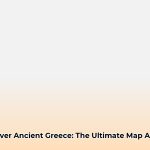Have you ever wondered about the captivating story of ancient Athens? It all began in Attica, a region that has shaped history for millennia. From its humble beginnings as a farming community, Attica ascended to become the epicenter of democracy and a dominant force in the ancient world. Discover how its people influenced the world we live in today, and how this land, once home to the mighty Athens, thrives as a vital part of modern Greece. Prepare yourself for an epic adventure through time! For a visual journey, check out this Ancient Athens map.
Ancient Greece’s Attica: A Historical Odyssey
Envision stepping back through the ages, to a rugged peninsula extending into the dazzling Aegean Sea. This is Attica, the birthplace of one of the world’s most influential civilizations. This historical odyssey explores its triumphs and eventual decline, a story as captivating as it is complex.
Early Attica: Cultivating the Land of Gods and Heroes – Exploring Attica’s Ancient Roots
Attica’s narrative commences in antiquity, with Neolithic farmers discerning the potential in its distinctive landscape. Picture a realm of undulating hills, fertile plains ideal for cultivating olives and grapes, and imposing mountains offering both challenge and sanctuary. These early settlers, adaptable and resourceful, fashioned a life from this environment. They established small hamlets, cultivated their fields, and engaged in trade with neighboring communities.
The Mycenaeans, recognized for their advanced bronze-working skills and majestic palaces, also left their imprint on the region, enriching Attica’s burgeoning identity. Did the fertile land alone foster this development, or were other factors at play? Historians continue to explore the precise circumstances that enabled Attica to prosper in these early epochs. The evidence suggests a combination of factors, including access to resources, strategic location, and the inherent ingenuity of its people.
The Ascent of Athens: From Modest Beginnings to a Powerful City-State – Understanding Athenian Ascendance
A small settlement near the coast initiates its remarkable ascent. Athens’ strategic location, boasting a natural harbor accessible by both land and sea, conferred a distinct advantage. It steadily expanded, attracting inhabitants from neighboring villages. Attica was not merely one unified entity; it comprised numerous independent communities, or “demes,” each with its own traditions and allegiances. Integrating these demes into a cohesive entity presented a formidable challenge.
Enter Cleisthenes, a statesman whose reforms proved pivotal. His genius resided in restructuring Athenian society, forging a system that united the people of Attica under a single government. This decisive moment laid the groundwork for the genesis of Athenian democracy. The reforms, implemented around 508/507 BCE, replaced the old clan-based system with a structure based on demes, fostering a sense of shared identity and political participation.
The Golden Age: Democracy, Drama, and a Devastating War – Athenian Golden Era
The Classical Age witnessed Athens attain its zenith. Its democratic system, albeit imperfect and exclusive, furnished a unique model of governance. The Parthenon atop the Acropolis, a temple dedicated to Athena, stood as an emblem of Athenian power, artistic mastery, and intellectual prowess. It was during this period that Athens made extraordinary cultural and political contributions to the world.
This era fostered artistic and intellectual flourishing, manifest in towering temples, Sophocles’ plays, and philosophical debates. The Peloponnesian War, a protracted conflict between Athens and Sparta, shook Attica’s foundations. The war’s devastating impact on the lives of ordinary Athenians serves as a stark reminder that even the mightiest empires are vulnerable. The long-term ramifications of this war continue to be debated by scholars, with some arguing that it marked the beginning of Athens’ decline.
After the Glory: Resilience in the Face of Adversity – Post Classical Period
The Peloponnesian War profoundly weakened Athens. Its power waned, and various rulers, from Macedonians to Romans, held sway over Attica for centuries. It was a turbulent epoch, characterized by political upheaval and economic hardship. Despite these challenges, the cultural and intellectual legacy of ancient Athens persisted, reverberating across the Mediterranean and influencing subsequent civilizations.
The region persevered, adapting to change and enduring even amidst foreign domination. The resilience of the Athenian spirit is a testament to the enduring power of its ideas and values.
Attica’s Enduring Legacy: From Ancient Glory to Modern Metropolis – Modern Athens and Enduring Legacy
From a modest agricultural society to a powerful city-state, and then through periods of decline and foreign rule, Attica’s journey is one of extraordinary transformation. The echoes of this history resonate even today. Modern Athens stands on the very ground where ancient events unfolded. As you traverse its streets, you encounter ruins, museums, and historical sites that bear witness to its rich past.
Its enduring legacy shapes not only Greece itself but also the very fabric of Western civilization. From our concepts of democracy to our appreciation for art and philosophy, the influence of ancient Attica continues to inspire us. The study of Attica’s history persists, yielding fresh insights and perspectives, enabling our understanding of this ancient land to evolve continually. Archaeological discoveries, ongoing research, and reinterpretations of historical texts contribute to a richer and more nuanced understanding of Attica’s significance.
How did the reforms of Cleisthenes impact the autonomy of Attic demes? – Unpacking the impact of Cleisthenes’ reforms
Attica, the rugged, sun-drenched land surrounding Athens, occupies a pivotal position in the narrative of ancient Greece. Its story unfolds across centuries of transformation, from scattered settlements to a powerful city-state, shaped by remarkable individuals and transformative events. One such pivotal event was the enactment of Cleisthenes’ reforms around 508/507 BCE. These reforms profoundly altered Athenian governance, and this section explores how they affected the autonomy of Attica’s individual demes.
Early Attica: A Patchwork of Communities – Exploring Attica Before Cleisthenes
Imagine Attica before Cleisthenes: a landscape populated with independent villages, each a deme (a self-governing unit), replete with its own traditions, local officials, and perhaps rivalries with its neighbors. These demes, rooted in kinship and shared land, enjoyed considerable autonomy. They managed their own affairs, levied taxes, and upheld their own religious practices. However, this system proved vulnerable to internal strife and external threats, often stemming from the dominance of powerful families within individual demes.
Archaeological and textual evidence suggests that these demes functioned as miniature city-states, with their own economies and social structures. They were the fundamental building blocks of Attica, but their decentralized nature hindered the region’s ability to act cohesively.
The Rise of Athens and the Need for Change – Changes in Attica
As Athens grew in power and influence, its ambitions outstripped its existing political framework. Internal conflicts, frequently fueled by the ambitions of powerful families, threatened stability. Moreover, the rise and fall of tyrants, such as Pisistratus and his sons, underscored the inherent weaknesses of the existing system. The concentration of power in the hands of a few individuals undermined the principles of self-governance and created an environment ripe for instability.
Cleisthenes’ Reforms: A Bold Restructuring – Cleisthenes’ revolutionary reforms
Cleisthenes’ reforms sought to dismantle the old clan-based system and prevent the emergence of future tyrants. This endeavor entailed a complete overhaul of Athenian political life. The existing four Ionic tribes, based on kinship, were replaced with ten new ones, each drawing members from a mixture of urban, coastal, and inland demes.
This innovative approach aimed to dilute the power of local elites and foster a broader Athenian identity. While demes retained some local functions, their independence was significantly curtailed. By reorganizing the citizenry into geographically diverse tribes, Cleisthenes effectively broke the power of the aristocratic families who had traditionally dominated Athenian politics.
The Impact on Demes: A Weakening of Local Power – Weakening Deme autonomy
The creation of larger, geographically diverse tribes weakened the influence of demes within the wider Athenian state. The introduction of the Council of Five Hundred (Boule), chosen by lot from each of the ten tribes, further shifted decision-making power away from local communities. Demes became components within a larger, more centralized Athenian political system. While this enhanced the overall strength and unity of Athens, it came at the cost of reduced autonomy for the individual demes.
The Balance: Centralization vs. Local Administration – Weighing Centralisation against Local Governance
Cleisthenes’ reforms did not entirely eliminate deme autonomy. While demes lost some degree of independence, they gained a more significant role in a larger, more vibrant Athenian democracy. Deme officials likely continued to play important roles in local administration, such as collecting taxes, settling disputes, and managing religious festivals. The reforms represented a shift of power, not its complete annihilation.
The demes continued to serve as vital administrative units, responsible for maintaining local infrastructure and ensuring the smooth functioning of community life. However, their decisions were now subject to the oversight of the central government in Athens.
A Legacy of Change – Lasting implications of reforms
Cleisthenes’ reforms fundamentally altered the relationship between Athens and its demes. While demes lost some degree of independence, they gained a more significant role in a larger, more vibrant Athenian democracy. The reforms not only impacted Athenian governance but also transformed the political landscape of the Greek world, shaping the very ideal of democracy itself. Cleisthenes’ vision of a unified and democratic Athens laid the foundation for the city’s future greatness.
Key Takeaways:
- Cleisthenes’ reforms fundamentally reshaped Athenian governance.
- The creation of ten new tribes decreased the power of local elites within demes.
- Demes maintained local functions, although their autonomy was substantially reduced.
- The reforms marked a shift toward a more centralized Athenian state.
- Cleisthenes’ reforms profoundly impacted the political landscape of ancient Greece.
Attica’s Demes and their Role in Athenian Governance – Demes’ Significant Role
Let’s embark on a journey back to ancient Greece, specifically Attica, the heartland of Athenian power. How did this region organize itself for governance? This section explores the role of Attica’s demes in the functioning of Athenian democracy.
Early Attica: Seeds of Democracy – The dawn of Democracy
Imagine Attica before Athens dominated the landscape. Scattered across the region were small, independent villages – the demes, focused on local concerns like agriculture and religious practices. These demes served as the building blocks of Athenian society, fostering a sense of community and self-governance.
The Rise of Athens: Cleisthenes’ Reforms – How Did Athens Arise
The unification of Attica under Athens wasn’t a smooth process, but this changed dramatically with Cleisthenes’ reforms in the late 6th century BC. Cleisthenes recognized the importance of incorporating the demes into a larger political structure. His reforms restructured Athenian governance by reorganizing Attica into 139 demes and grouping them into ten tribes.
These reforms laid the groundwork for Athenian democracy and ensured that the demes played a crucial role in the functioning of Athenian democracy. By creating a system of proportional representation, Cleisthenes ensured that all citizens, regardless of their deme, had a voice in the Athenian government.
Each deme had its own assembly, officials, and religious cults, but they were now integrated into the larger Athenian political system. Citizens were registered with their deme, a crucial step in participating in Athenian democracy, and ensured broader representation throughout Attica.
Athenian Democracy: The Demes in Action – Democracy In Athens
Demes acted as electoral units, citizens then voted within their local deme. Demes also provided essential military manpower through their citizen militias, fostered loyalty and local defense, and ensured the stability of the Athenian state. Each deme was a microcosm of the broader Athenian political system, reflecting the values of self-governance and civic participation.
The Peloponnesian War and Beyond: Change and Transformation – Attica After the War
The Peloponnesian War (431-404 BC) significantly impacted Attica. Devastating invasions and sieges tested the resilience of the demes. The war’s consequences reshaped Athenian society and governance. The demes, once centers of local life, faced considerable challenges, including population decline and economic hardship.
Despite these challenges, the demes continued to function as vital administrative units, responsible for maintaining local order and providing essential services to their communities.
Key Takeaways:
- Attica’s demes were the foundational units of Athenian society.
- Cleisthenes’ reforms integrated the demes into a larger political system.
- Demes acted as electoral, administrative, and military units.
- The Peloponnesian War significantly impacted the demes’ role and function.
- Understanding the demes is crucial to understanding the development of Athenian democracy.
Agricultural Practices and Economic Shifts in Ancient Attica – Exploring ancient Attica Agriculture
Key Takeaways:
- Attica’s ancient economy wasn’t solely subsistence-based.
- Advanced farming techniques produced surpluses for trade.
- A network of local markets, beyond Athens and Piraeus, facilitated exchange.
- Efficient, diverse transportation methods moved goods.
- The full extent of market exchange still needs further investigation.
Early Attica: Humble Beginnings and Agricultural Foundations – Attica ancient agriculture
Imagine Attica in its infancy: rocky terrain, olive groves, and vineyards shaped the land. Early inhabitants, navigating this challenging landscape, developed innovative farming techniques to maximize yields. The Mycenaean period witnessed further agricultural development, laying the groundwork for future prosperity.
The Athenian Ascent: From Demes to Dominance – Agriculture and Athens Ascendance
The rise of Athens transformed Attica’s agricultural landscape. The city’s growth necessitated efficient food production and distribution. Cleisthenes’ reforms reorganized Attica into demes. This system fostered a more robust local economy, channeling agricultural output to Athens, and boosting the efficiency of farming.
The Classical Age: Power, Prosperity, and the Peloponnesian War – Classical Era and its impact
The Classical era showcased Attica’s agricultural prowess. However, the Peloponnesian War significantly impacted the region’s economy. The war disrupted trade and agriculture, highlighting the fragility of a robust system, and revealing the interplay between political instability and economic fluctuations.
Post-Classical Attica: Decline and Adaptation – Agriculture declines
Following the Classical era, Attica’s fortunes fluctuated. Foreign rule and shifting power dynamics impacted agricultural practices. The resilience of Attic agriculture, in the face of repeated upheaval, underscores its importance to the region’s survival. Despite periods of decline, agriculture remained a cornerstone of the Attic economy, providing sustenance and employment for its inhabitants.
Transportation and Market Networks: The Unsung Heroes – Attica transportation success
The efficiency of Attic agriculture wasn’t just about farming techniques, it was also about how produce reached consumers. Attic farmers used diverse, cost-effective methods: donkeys, panniers, even carrying goods on their shoulders. The existing road network facilitated transport, connecting rural demes with bustling Athenian markets. This network wasn’t just roads, it was the circulatory system of Attica’s economy.
The Evidence: Beyond the Literary Ideal – Facts about Attica agriculture
Archaeological evidence points to a high level of market integration. The numerous deme markets and advanced farming techniques strongly suggest the existence of extensive market networks that directly challenge assumptions of self-sufficiency. This contradiction between literary ideals and material reality provides an opportunity for reevaluation. Ongoing archaeological research continues to shed light on the complexities of Attic agriculture and its role in the region’s economy.
- Unlock Ancient Greece Coloring Pages: Fun Educational Activities for Kids - August 12, 2025
- Unlock the Secrets of Ancient Greek Literature: A Comprehensive Guide - August 12, 2025
- Master Ancient Greece Word Search: Fun Learning Games - August 12, 2025
















